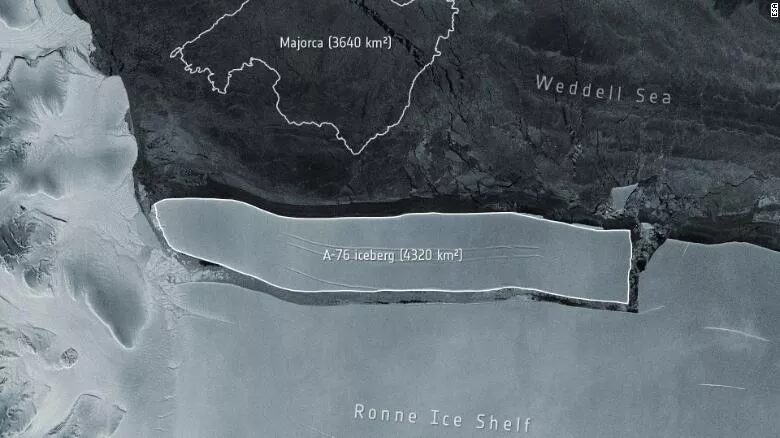
Den fingerformede klump is, der er cirka 170 kilometer lang og 25 kilometer bred, blev set af satellitter, da den kalvede fra den vestlige side af Antarktis' Ronne Ishylde, ifølge European Space Agency. Berget flyder nu frit på Weddellhavet, en stor bugt i det vestlige Antarktis, hvor opdagelsesrejsende Ernest Shackleton engang mistede sit skib, Endurance, i pakis.
Isbjerget på 4,320kvadratkilometer (som nu er verdens største og er blevet kaldt A-76 efter Antarktis-kvadranten, hvor det først blev set), blev fanget af Den Europæiske Unions Copernicus Sentinel, en konstruktion med to satellitter der kredser om jordens poler. Satellitterne bekræftede en tidligere observation foretaget af British Antarctic Survey, som var den første organisation, der bemærkede løsrivelsen.
Kommentar: Delvist over sat af Sott.net fra World's largest iceberg A-76 breaks off of Antarctica Der er en række oplysende kommentarer med links til artiklen.
Because the ice shelf that this berg calved from was already floating on water, the event won't directly impact sea levels. However, ice shelves help to slow the flow of glaciers and ice streams into the sea; so indirectly, the loss of parts of an ice shelf eventually contributes to rising seas, according to the National Snow and Ice Data Center (NSIDC).
Comment: Note that these claims of 'rising seas', like global warming, has failed to materialize: Kiribati and China to develop farm land in Fiji, land had been predicted to 'disappear under a rising ocean'
The NSIDC also says that the continent of Antarctica, which is warming at a faster pace than the rest of the planet, holds enough frozen water to raise global sea levels by 200 feet (60 meters). Scientists don't think that human-induced climate change caused the calving of A-76 or its nearby predecessor, A-74.
Comment: It's rather curious that, for once, they're not attributing this to 'AGW', and that may be because calving tends to occur due to the growth of ice. It is true that some areas of Antarctica have been found to be warming and glaciers have indeed been melting, however any warming seems to be coming from below, seemingly because of a rise in activity from undersea volcanoes; meanwhile the temperature above ground is cooling so significantly it's killing wildlife.
"A76 and A74 are both just part of natural cycles on ice shelves that hadn't calved anything big for decades," Laura Gerrish, a researcher at the British Antarctic Survey, wrote on Twitter. "It's important to monitor the frequency of all iceberg calving, but these are all expected for now."
Comment: Suddenly natural cycles are a thing? It's notable that little happened for decades, when the planet did experience a period of brief warming. This is known to occur before temperatures plunge, as they are doing now: Global cooling to replace warming trend that started 4,000 years ago - Chinese scientists
Satellites will continue to track the new iceberg, much as they did for A-68A, the previous title holder for the world's largest iceberg. After splitting from the Antarctic ice sheet in 2017, A-68A was set loose by ocean currents in 2020 and came perilously close to colliding with South Georgia Island, a breeding ground for seals and penguins. The rogue berg shattered into a dozen pieces before it caused any harm, Live Science previously reported.
Comment: Note that this occurred only 4 years ago, reflecting the possible uptick in calving activity.
The Ronne Ice Shelf, which birthed the recent iceberg, is mostly spared from influxes of warm water that disrupt the Antarctic's natural cycle of ice calving and regrowth. But not all parts of West Antarctica have been quite so lucky. Live Science reported in April that the Thwaites Glacier, or the "Doomsday Glacier," was discovered to be melting faster than previously thought. This was due to a warm water current from the east whittling away at the vital "pinning points" that anchor the shelf to the land.



Kommentar: See also:
- Landslide induced mega-tsunami 'could happen at anytime' at Alaska's Barry Glacier
- Himalayan glacier bursts in India causing flash flooding & destroying dam, 150 feared dead
- Black auroras captured over Scotland
- HUGE meteor fireball lights up western China's dark morning skies
- Professor Valentina Zharkova: "We entered the 'modern' Grand Solar Minimum on June 8, 2020"
And check out SOTT radio's: